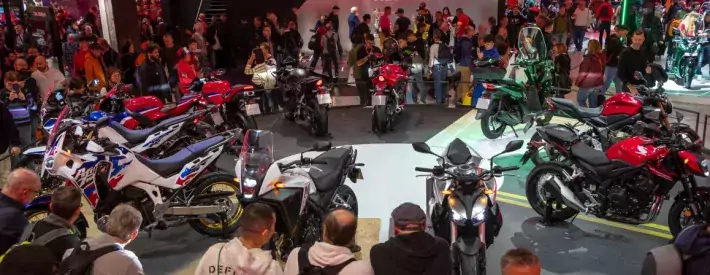EICMA: Five technologies changing powered two-wheelers

*Image courtesy of EICMA
It’s that time of year again… EICMA has come to an end and the motorcycling world is all the richer for it. A host of exciting machines, innovative technologies and new equipment has been unveiled at the annual exhibition, which took place at Italy’s Fiera Milano Rho from Thursday 9th to Sunday 12th November 2023.
British fans will soon be able to see many of these products and prototypes at Motorcycle Live, which launches at the NEC later this week. But for the meantime, here’s our rundown of EICMA’s top tech.
1 Royal Enfield Electric Himalayan
Adventure fans were eagerly awaiting the new 452 Himalayan, when Royal Enfield threw in a glimpse of the future in the form of the Electric Himalayan Testbed. Currently in an advanced stage of development, and undergoing testing in its namesake mountain range, the electric Himi builds on the model’s tried and tested architecture with an electric powertrain and an in-house designed battery box that serves as the main structural element. New materials such as Organic Flax Fibre feature in the composite bodywork, while the fuel tank appears to have been replaced with the socket for a standard Level 2 charger.
While a timeline hasn’t yet been released, this is clearly more than a concept - the model on display at the show was quite proudly caked in mud.
2 Kawasaki Z7 Hybrid
A hybrid motorcycle? Make it make sense… Well, Kawasaki did exactly that with the Ninja Hybrid, unveiled in October 2021 and finally launched last month. And at EICMA, the Japanese manufacturer bolstered its Hybrid offering with the launch of the Z7 Hybrid. Build on the same platform as the Ninja, the Z7 features a 451cc parallel twin, paired with a 12bhp max traction motor (powered by a centrally-mounted 48-volt battery). Combined, these powertrains put out 69bhp and 44.5lb-ft of torque - roughly equivalent to 650cc performance, albeit with “the instant acceleration to rival that of a 1,000cc-class super sport model from a standing start” using the e-boost function (Kawasaki claim). Add in a 217-mile range and both automatic and manual shifting, and it’s a very appealing prospect indeed.
3 Bosch Radar-based assistance systems
It wasn’t all about EVs… At EICMA 2023, Bosch unveiled the latest in its range of rider assistance systems, including improved forward and rear radar.
Bosch has a track record in improving motorcycle safety, through its anti-lock braking and motorcycle stability control systems. And now, its next-generation radar system could prevent up to “one in seven motorcycle accidents,” by detecting hazards and initiating emergency interventions to avoid a collision.
4 MV Agusta LXP Orioli
Luxury and adventure don’t usually go hand in hand. In fact, when it comes to adventure motorcycling, the two are very much mutually exclusive. But that hasn’t stopped MV Agusta from finally bringing its Lucky Explorer 9.5 prototype to fruition, in the form of the LXP Orioli - notably the brand’s first adventure bike. The namesake of four-time Dakar winner Edi Orioli (who will sign each bike) the model will be powered by a 931cc triple, making 124bhp at 10,000rpm and 102Nm of torque at 7,000rpm.
With design cues more akin up a bespoke track bike, and a limited production run of just 500 models, the LXP Orioli isn’t your average off-roader. And despite MV touting extensive testing alongside KTM, with a rumoured price tag of €30,000, we’re not sure how many will be used off-road in anger.
5 Honda E-clutch
Honda pioneered clutchless riding with its dual clutch transmission, launched all the way back in 2009. And now, the Japanese manufacturer has unveiled an even simpler system…
The Honda E-clutch is effectively a pair of electric motors that work via the existing clutch mechanism and are managed by the ECU, enhancing shifting and working to pull the clutch in when the rider stops. This means that without so much as touching the clutch lever, the rider can put the bike into gear, pull away, shift through the box and come to a stop without stalling. They can override the system simply by using the clutch lever.
Currently planned on the CB650R and the CBR650R, the best part of this system is that it could hypothetically be retrofitted to any bike with a conventional clutch.




